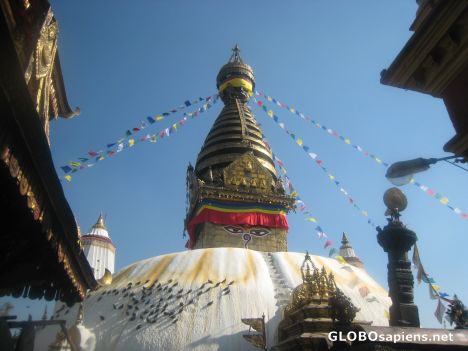Pashupati

Pashupati (Sanskrit: पशुपति Paśupati), "Lord of cattle", is an epithet of the Hindu deity Shiva.[1] In Vedic times it was used as an epithet of Rudra.[2] The Rigveda has the related pashupa "protector of cattle" as a name of Pushan. The Pashupatinath Temple is the most important Hindu shrine for all Hindus in Nepal and also for many Hindus in India and rest of the world.
The name has also been applied to a figure, probably a deity, depicted as sitting among animals, on a seal discovered in the context of the Indus Valley Civilization.
Pashupati seal
A seal discovered during excavation of the Mohenjodaro archaeological site in the Indus Valley has drawn attention as a possible representation of a "yogi" or "proto-Shiva" figure.[3] This "Pashupati" (Lord of Animals, Sanskrit paśupati)[4][5] seal shows a seated figure, possibly ithyphallic, surrounded by animals.[6][7][8] The pose is reminiscent of that of Cernunnos, the Horned God as found, for example, on the Gundestrup Cauldron. Some observers describe the figure as sitting in a traditional cross-legged yoga pose with its hands resting on its knees.
Imagery
The discoverer of the seal, Sir John Marshall, and others have claimed that this figure is a prototype of Shiva, and have described the figure as having three faces, seated on a throne in a version of the cross-legged "lotus" posture of Hatha Yoga. The Yogi's penis is erect, with both testicles prominently visible. The precise placement of both heels under the scrotum is an advanced Tantric Yoga technique known as Bandha, meaning knot or "lock". It is normally used to sublimate and redirect sexual energy and can endow the practitioner with spiritual powers.[9]
A large tiger rears upwards by the Yogi's right side, facing him. This is the largest animal on the seal, shown as if intimately connected to the Yogi; the stripes on the tiger's body, also in groups of five, emphasize the connection. Three other smaller animals are depicted on the "Marshall" Shiva seal. It is most likely that all the animals on this seal are totemic or "heraldic" symbols, indicating "tribes", "people" or geographic areas. On the Shiva seal, the tiger, being the largest, represents the Yogi's people, and most likely symbolizes the Himalayan region. The elephant probably represents central and Eastern India, the bull or buffalo South India and the rhinoceros the regions West of the Indus river.[9]
Archaeologist Jonathan Mark Kenoyer, current Co-director of the Harappa Archaeological Research Project in Pakistan and Indologist Heinrich Zimmer agree that the 'Pashupati' figure shows a figure in a yoga posture.[10][11][12]
Critiques
Gavin Flood characterizes these views as "speculative", saying that while it is not clear from the seal that the figure has three faces, is seated in a yoga posture, or even that the shape is intended to represent a human figure, it is nevertheless possible that there are echoes of Shaiva iconographic themes, such as half-moon shapes resembling the horns of a bull.[3][13] Historian John Keay is more specifically dismissive, saying:
...there is little evidence for the currency of this myth. Rudra, a Vedic deity later identified with Shiva, is indeed referred to as pasupati because of his association with cattle; but asceticism and meditation were not Rudra's specialties, nor is he usually credited with an empathy for animals other than kine. More plausibly, it has been suggested that the Harappan figure's heavily horned headgear bespeaks a bull cult, to which numerous other representations of bulls lend substance.[14]
Archaeologist Gregory Possehl also disagrees with the Proto-Shiva theory,[15] but contends that "the posture of the deity...is a form of ritual discipline, suggesting a precursor of yoga."[16] Possehl also states that this view:
...is supported by several other yogi images in the corpus of Mature Harappan materials....These diverse images suggest that the Indus pose of ritual discipline was used in more than one way and that their buffalo god did not have exclusive access to it. Taken as a whole, it appears that the pose may have been used by deities and humans alike....This presents an interesting possibility: Some of the Harrapans were devoted to ritual discipline and concentration, and this was one of the preoccupations of at least one of their gods."[16]




